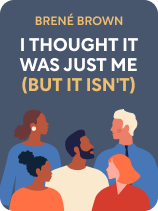

This article is an excerpt from the Shortform book guide to "I Thought It Was Just Me (but it isn't)" by Brené Brown. Shortform has the world's best summaries and analyses of books you should be reading.
Like this article? Sign up for a free trial here.
Why does Brené Brown encourage connection between people? How does connecting with others stop toxic shaming?
I Thought It Was Just Me (but it isn’t) gives different practices for developing empathy and combating shame, one of which is connection. Brené Brown claims that connecting with others helps you establish mutual support.
Let’s dive deeper into the beauty of connecting with others and how it creates a positive environment.
Learn to Talk About Shame and Connect With Others
According to Brené Brown, connection is crucial to combating shame because it helps you put courage and compassion into action. Further, once you learn how to express your own shame and ask for support, you’ll be better equipped to listen to others and provide them with support.
(Shortform note: Research supports the idea that having social support systems is crucial to building resilience against negative experiences and emotions (like shame). Studies have even noted a link between social support and the neurocognitive systems and genetic mechanisms related to resilience. However, like Brown, Douglas Stone, Bruce Patton, and Sheila Heen explain that learning how to talk about our experiences and listen to others is crucial to ensuring that these connections have a positive effect. In Difficult Conversations, Stone, Patton, and Sheen explain that if we don’t share our feelings in a productive way and truly listen to others when they share theirs, we could end up misunderstanding each other, not getting what we need, and ultimately damaging our relationships).
How To Talk About Shame
Before you can effectively connect with others, you must first learn how to talk about shame. Brown explains that shame is a complex and often undiscussed topic, meaning most people don’t have the vocabulary to express their feelings and experiences. Consequently, to have a productive discussion, you must understand how to effectively express yourself and understand others.
To constructively talk about shame, put everything you’ve learned in Practice #1 and Practice #2 into words—explain the identity that’s causing your fear, how it makes you feel, why it makes you feel that way, and what kind of support you need instead.
For example, if you ask a question in school and a classmate makes you feel stupid by implying that your questions are dumb, you can explain to them:
“When I ask questions and you say things like ‘wasn’t that obvious?’, you really hurt me and make me feel stupid. I ask questions because I want to ensure that I fully understand topics, but when you make negative remarks like that, it discourages me from wanting to learn and creates a hostile environment. Instead, I’d prefer if you either offered to answer my questions or remained quiet so the professor can answer them.”
(Shortform note: While the authors of Difficult Conversations agree with Brown’s recommendations for talking about feelings (like shame), they recommend a slightly different approach to truly ensuring a positive outcome. First, control your emotions before entering the conversation. Otherwise, you may engage in negative behaviors like yelling or blaming. Further, instead of sharing your fears, feelings, explanations, and needs all in one go, give the other person the opportunity to respond to each factor. After explaining why you feel the way you do, let the other person share their own feelings. Then, solve the issue together so that both parties’ needs are fulfilled.)
How to Connect With Others
Once you’re able to effectively express your experiences of shame to others and ask for their support, Brown says that you can use these abilities to support others and prevent shame.
To support others, be willing to listen to their experiences and pain. When they share their story with you, you can laugh, cry, and feel their emotions with them by tapping into your own experiences. You can share your story with them and let them know that they’re not alone in their pain. You can reassure them that they aren’t defective and provide them with a critical perspective on shame to help them see the bigger picture.
Another way to support others and change the culture of shame is speaking up when you see people being cruel. If you’re in a group, you can stop a shamer by asking a question that makes them reconsider their actions, and you can redirect the conversation away from shame.
For example, if someone is casting doubt on another person’s intelligence, you can redirect the conversation by saying something like, “Maybe he’s really busy with work and didn’t have time to study. I wonder if it would help to form a study group and ask if he’d like to join.” That way, you’re making the shamer confront their negative actions while simultaneously suggesting a way to provide support to the person being shamed.
When questioning and redirecting the conversation doesn’t work, directly address the issue with the shamer in a private conversation. Use the technique from the previous section to explain to the shamer how they’re causing shame, how it makes others feel, why it makes them feel that way, and how they can provide support instead. Brown emphasizes avoiding confrontation in a group setting because you’re likely to cause more shame when you bring public attention to the shamers’ bad behavior.
(Shortform note: Many experts agree that holding others accountable for their bad behavior (like shaming) is important to creating positive environments and culture. However, others explain that it’s not always your place to do so—even if you think you’re witnessing a shaming incident like those Brown discusses. For example, maybe you think someone is being shamed and is too shy to confront their shamer, but they actually don’t feel ashamed at all. In this scenario, confronting the perceived “shamer” could create issues for everyone involved. Before interjecting on someone else’s behalf, have a conversation with that person to determine how they feel about the situation and whether they feel intervention is necessary.)

———End of Preview———
Like what you just read? Read the rest of the world's best book summary and analysis of Brené Brown's "I Thought It Was Just Me (but it isn't)" at Shortform.
Here's what you'll find in our full I Thought It Was Just Me (but it isn't) summary:
- Brené Brown's guide on what shame is, why it happens, how it impacts our lives
- How to build empathy and combat shame
- Why it's important to talk about shame with others






